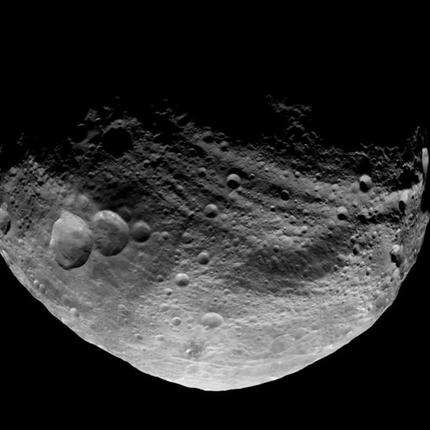Dawn spacecraft gets cozy with massive asteroid

(AP) -- Scientists are busy poring over images of the massive asteroid Vesta, the first time it has been photographed up close.
The Dawn spacecraft last month slipped into orbit around the 330-mile-wide rocky body with little fanfare and began beaming back incredible details of the pockmarked surface that resembles Earth's moon.
Since entering orbit, Dawn has taken more than 500 images, while refining its path and inching ever closer to the surface to get a better view. The probe will officially start collecting science data next week once it is positioned 1,700 miles from the surface.
Dawn so far has imaged the entire sunlit side of Vesta. Last week, it passed over a part of the surface hidden in the shadows and saw distinct grooves.
Analyzing the surface "enables us to determine what has happened to Vesta over the eons," said the mission's chief scientist, Christopher Russell of the University of California, Los Angeles.
Currently some 117 million miles from Earth, Vesta is the second-most massive resident of the asteroid belt, a zone between Mars and Jupiter littered with hundreds of thousands of space rocks orbiting the sun. The belt formed some 4.5 billion years ago around the same time and under similar conditions as Earth and the inner planets.
It's thought that larger chunks such as Vesta could have coalesced into planets had they not been foiled by Jupiter's gravity. Despite being denied planethood, asteroids are of interest to researchers because they date back to the early solar system.
Powered by ion propulsion instead of conventional rocket fuel, Dawn slid around Vesta on July 15 after a 1.7 billion-mile cruise. Most orbit insertions are tricky because a speeding craft has to slow down or risk overshooting its target.
Since Dawn has been traveling slow relative to Vesta, the orbit capture was a ho-hum event.
"It wasn't dramatic, but it is exciting," said chief engineer Marc Rayman of NASA's Jet Propulsion Laboratory.
Launched in 2007, Dawn is the first mission to explore Vesta and Ceres, the two largest members of the asteroid belt. It's also the largest interplanetary probe launched by NASA, measuring 64 feet tip to tip with its solar panels unfurled.
Though the $466 million project was conceived long before the United States decided to send astronauts to an asteroid by next decade, the data gathered by Dawn should help future manned missions.
Dawn will circle Vesta for a year, hovering as close as 110 miles from the surface, before moving on to Ceres, where it will arrive in 2015.
Unlike dry and rocky Vesta, Ceres is icy and may have frost-covered poles. Due to the possible presence of frozen water, Dawn will not be able to venture as close to Ceres' surface for fear of contaminating it.
©2011 The Associated Press. All rights reserved. This material may not be published, broadcast, rewritten or redistributed.




















